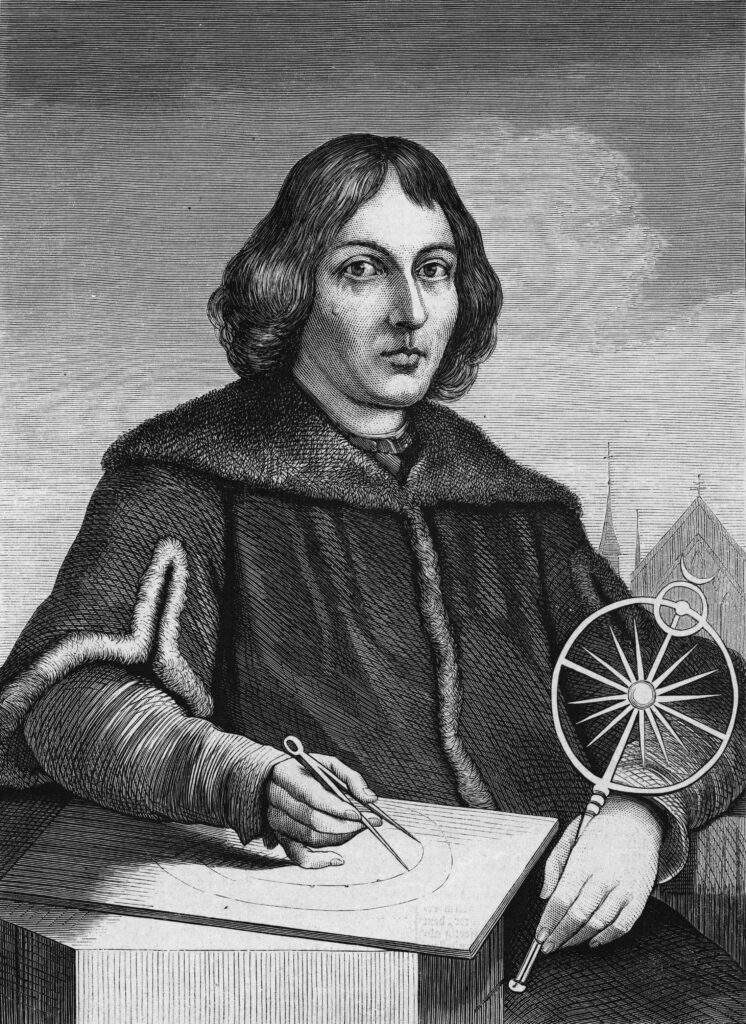Nicolaus Copernicus was a Polish astronomer who put forth the theory that the Sun is at rest near the center of the Universe, and that the Earth, spinning on its axis once daily, revolves annually around the Sun. This is called the heliocentric, or Sun-centered, system.
Copernicus was born on February 19, 1473, in Thorn (now Torun), Poland. Nicolaus Copernicus is the Latin version of his name, which he chose later in life as was the custom among scientists of the day. His original name may have been Mikolaj Kopernik. After his father died when Copernicus was only ten, his uncle, Bishop Lukasz Watzenrode, took him under his care and ensured Copernicus received a good education prior to entering the priesthood. From 1491 to 1495, Copernicus attended the Cracow Academy, where he first learned astronomy. For more than a thousand years, astronomy had been based on the Ptolemaic, or Geocentric Model of the Universe, which stated that the Earth was the center of all creation, with the Sun, planets, and stars all orbiting it.
Copernicus studied law and medicine at the Universities of Bologna and Padua, then returned to Poland after witnessing a lunar eclipse in Rome in 1500. In 1501 he went back to Italy for further studies at the Universities of Padua and Ferrara and received a doctorate in canon law from the later in 1502. It was in this period that he probably read ancient Greek theories on the movement of the Earth through the heavens, including some writings that espoused a heliocentric view that all of the planets, including the Earth, orbited the Sun. This was in direct contradiction of the teachings of the Catholic Church, which espoused the Ptolemaic view of the Universe.
In 1504, Copernicus began the research that culminated in his heliocentric theory. He had already returned to Poland, taking a position at the Collegiate Church of the Holy Cross in Breslau, Silesia (now Wroclaw, Poland). In 1512, Copernicus became canon in the Ermland Chapter at Frauenburg (now Frombork, Poland). In his new position, he was able to devote more time to his study of astronomy and had an observatory built in one of the towers in the town wall. Until just before his death, Copernicus conducted most of his astronomical observations and calculations there, usually working alone. His observations were made with the “naked eye,” as the invention of the telescope would not occur for decades after his death. In 1514, he distributed a hand-written, unpublished manuscript entitled the Little Commentary that included the following axioms:
1) There is no one center in the Universe.
2) The Earth’s center is not the center of the Universe.
3) The center of the universe is near the Sun.
4) The distance from the Earth to the Sun is imperceptible compared with the distance to the stars.
5) The rotation of the Earth accounts for the apparent daily rotation of the stars.
6) The apparent annual cycle of movements of the Sun is caused by the Earth revolving around it, and,
7) the apparent retrograde motion of the planets is caused by the motion of the Earth from which one observes.
After years of observation and calculations, he published his masterpiece, On the Revolutions (De revolutionibus orbium coelestium), just before his death in 1543. It contained the mathematical and astronomical data that form the basis of the Copernican system. Central to his model is his proposal that the Earth has three distinct motions: a daily axial rotation, an annual rotation about the Sun, and a third motion related to precession (the 25,800-year-long cycle reflecting the changing position of the Earth in space). In the book’s introduction, Copernicus credits his heliocentric hypothesis to the ideas of ancient Greek writers such as Aristarchus and Philolaus.
Copernicus had hesitated for years to publish his theory, not because he feared he had contradicted Catholic dogma (though De Revolutionibus was on the Vatican’s Index of Forbidden Works from 1616 until 1835), but rather because he thought, even after working on it for three decades, that his theory was still incomplete. According to legend, he first saw a published copy of his work from his deathbed.
Copernicus died of a cerebral hemorrhage on May 24, 1543. His writings soon created controversy in European scientific and religious circles by challenging many beliefs that had become religious dogma since the end of the Classical Era a thousand years before. Copernicus was the first to combine physics, astronomy, and mathematics into a fact-based model of the universe. Ironically, Copernicus, a devout Catholic, believed his theory did not actually contradict what the Bible said about the structure of the Universe.
Two Italians who lived decades after Copernicus suffered for supporting his beliefs. Giordano Bruno not only agreed that the Earth revolved around the Sun, he even suggested space might be infinite, that our solar system was but one of many, and that there were possibly other worlds inhabited by beings that might have intelligence equal to or even superior to men. In 1600 Bruno was condemned by the Papal Inquisition and burned at the stake for his views. Galileo Galilei, whose discovery of the moons of Jupiter in 1610 lent credence to the Copernican model was condemned by the Church in 1633, and forced to renounce all belief in the heliocentric system lest he suffer the same fate as Bruno.
Despite such initial reactions, by 1700 most scientists had embraced Copernicus’ ideas, and the Copernican theory, after further refinement by other researchers, foremost among them Johannes Kepler, forever changed man’s view of the universe and his role in it. Asteroid 1322 Copernicus, Copernicus Crater on Mars, and the Nicolaus Copernicus University in Torun, Poland have named in honor of the man some credit with beginning the Scientific Revolution.

